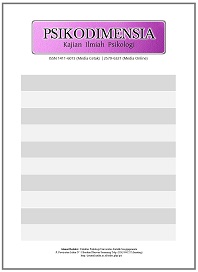Determinant Factors of Customers Loyalty in Hotels in Bandung City
Abstract
Keywords
Full Text:
PDFReferences
Achyar, A., & Brilliant, M. A. (2013). The impact of satisfaction and trust on loyalty of e-commerce customers. Asean Marketing Journal, 51-58.
Ahdyanugroho, R. (2018). Pengaruh kualitas pelayanan terhadap loyalitas pelanggan dengan kepuasan dan kepercayaan sebagai variabel mediasi (studi pada pelanggan jasa kebersihan King Clean di D.I. Yogyakarta). Yogyakarta: Universitas Muhammadiyah Yogyakarta.
Armstrong, S., & Cools, S. (2009). Cognitive styles and their relevance for business and management. New York: Springer.
Bastiar, Z. (2010). Service exzellent dalam rangka membentuk loyalitas pelanggan. Manajerial, 54-65.
Becerra, E., Badrinarayanan, V., & Kim, C. (2013). Influence of thinking tendencies on online transaction of hybrid relatilers. Journal of Business Research,, 336-344.
Bhakar, S., Bhakar, S., & Bhakar, S. (2015). Customer satisfaction or service quality-identifying mediating variable and evaluating behavioral intention model in hotel industry: an sem approach. The International Journal Research Publication’s Research Journal of Social Science & Management, 111-124.
Bobalca , C., Gatej, C., & Ciobanu, O. (2012). Developing a scale to measure customer loyalty. Procedia Economics and Finance, 623-628.
Bricci, L., Fragata, A., & Antunes, J. G. (2015). The Effects of Trust, Commitment and Satisfaction on Customer Loyalty in the distribution sector. Journal of Business Economics and Management, 1-5.
Budijanto, R. (2013). Thinking styles, teamwork quality and performance. Australia: University of Canberra.
Chang, S. S. (2014). Does style of thinking make differences in cosumer judgments on brand extension. Comtemporary Management Research, 165-178.
Gisela, E., & Japarianto, E. (2014). Pengaruh customer satisfaction dan switching barrier terhadap customer loyalty dengan customer trust sebagai variabel moderating pada toko bunga Petra Togamas Surabaya. Jurnal Manajemen Pemasaran Petra, 1-10.
Hapsari, R., Clemes, M., & Dean, D. (2017). The impact of service quality, customer engagement and selected marketing constructs on airline passanger loyalty. International Journal of Quality and Service Sciences, 21-40.
Jannah, A., Mawardi, K., & Abdullah. (2017). Pengaruh Customer Relationship Management pada Kepuasan dan Loyalitas Pelanggan. Jurnal Administrasi Bisnis, 38-45.
Juana, I. R., Sukaatmadja, I. G., & Yasa, N. K. (2017). Peran persepsi switching cost memoderasi customer satisfaction terhadap customer loyalty studi pelanggan PT. Bank Mandiri (Persero), Tbk. E-Jurnal Ekonomi dan Bisnis Universitas Udayana, 593-618.
Kotler, P., & Keller. (2016). Marketing Management. England: Pearson Education Limited.
Michael. (2015). Customer Satisfaction. International Encyclopedia of the Social & Behavioral Sciences, 2nd ed, Vol.5, pp. 6-21.
Minh, N., & Huu, N. (2016). The relationship between service quality, customer satisfaction, and customer loyalty (an investigation in Vietnamese retail banking sector). Journal of Competitiveness, 103-116.
Monga, A., & John, D. (2010). What Makes Brands Elastic? The Influence of Brand Concept and Styles of Thinking on Brand Extension Evaluation. Journal of Marketing, 2-3.
Novianti, Suryoko, S., & Nugraha, H. (2013). Pengaruh kepuasan pelanggan dan hambatan berpindah terhadap retensi pelanggan kartu prabayar Simpati di wilayah Semarang. Journal Management, 1-10.
Okazaki, S., Mueller, B., & Diehl, S. (2013). A Multi-Country Examination of Hard-Sell and Soft-Sell Advertising : Comparing Global Consumer Positioning in Holistic- and Analytic- Thingking Cultures. Journal of Advertising Research.
Puriwat, W., & Tripopsakul, S. (2014). The investigation of the influence of service quality toward customer engagement in service dominant industries in thailand. International Conference on Business, Management and Governance, 42-49.
Rai, A., & Medha, S. (2013). The antecedents of customer loyalty (an empirical investigation in life insurance context. Journal of Competitiveness, 139-163.
Ramseook, S. (2010). Service quality in the public service. International Journal of marketing and marketing research, 37-41.
Risdianto, G., & Japarianto, E. (2014). Pengaruh customer satisfaction dan switching barriers terhadap customer loyalty dengan customer trust sebagai variabel moderating pada toko buku putra togamas Surabaya. Jurnal Manajemen Pemasaran Petra, 1-10.
Riskiyati, I. (2012). Pengaruh kepuasan terhadap loyalitas dengan mediasi komitmen pada nasabah Bank BCA Ngoro Mojokerto,. Journal of Business and Banking, 241-254.
Singh, V., & Jain, A. (2015). Consumer trust in Retail: Development of a multiple scale. Journal of Economics, Business and Management, 971-976.
So, K., King, C., Sparks, B., & Wang, Y. (2014). The role of customer engagement in bulding consumer loyalty to tourism brands. Journal of Travel Research, 1-15.
Song, L., Swaminathan, S., & Anderson, R. (2015). Differences in customer’s online service satisfaction across cultures: the role of thinking style. Journal of Marketing Channels, 52-61.
Sugiyarmasto, & Sudarmadi. (2012). Analisis faktor-faktor yang mempengaruhi komitmen konsumen. 1-16.
Suparmi, & Handhoko, K. (2018). Pengaruh kepuasan, kepercayaan dan komitmen terhadap loyalitas pelanggan pada PT. Yodya Karya (Persero) Cabang Utama Semarang. Jurnal Ilmiah UNTAG Semarang, 102-117.
Tabrani, M., Amin, M., & Nizam, A. (2018). Trust, commitment, customer intimacy, and customer loyalty in islamic banking relationships . International Journal of Bank Marketing, 823-848.
Varshney, N. (2016). Exploring service quality, switching barriers and customer loyalty: mediating role of switching barriers. Journal of Marketing and Consumer Research, 1-5.
Vivek, S., Beatty, S., & Morgan, R. (2012). Customer engagement: exploring customer relationships beyond purchase. Journal of Marketing Theory and Practice, 127-145.
Wu, L. W. (2011). Inertia: spurious loyalty or action loyalty? Asia Pacific Management Review, 31-50.
Yunus, & Budianto. (2014). Pengaruh kualitas pelayanan dan fasilitas terhadap kepuasan pelanggan. Jurnal Ilmu dan Riset Manajemen, 1-20.
DOI: https://doi.org/10.24167/psidim.v18i2.2003
Print ISSN : 1411-6073 | online ISSN : 2579-6321 View My Stats

This work is licensed under a Creative Commons Attribution 4.0 International License.





















